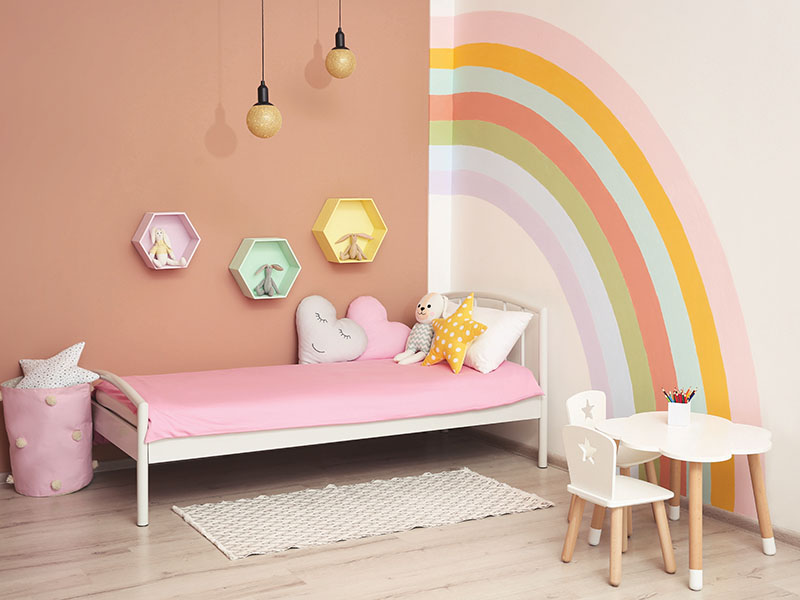Use colours wisely to enhance children’s emotional well-being

Usha Rani
Colours are not merely about decoration and aesthetics; they are infused with emotional and psychological weight. Thoughtfully chosen colour schemes promote positive emotional, behavioral and cognitive outcomes in children
Colour is a powerful but often overlooked element in promoting children’s emotional health and well-being. The colour shades that surround children — on walls at home, classrooms, bed linen, accessories, the study corner — positively or negatively shape their emotions and behaviour. A comprehensive review published in Sciety (March), an open access online platform, synthesizing research on how different colours impact children’s emotional well-being, cognitive capability, and behavior in environments such as homes, schools, and play areas, found that colours greatly affect children’s mood, attention, learning, and social interaction. For instance, warm colours like red and yellow stimulate energy and alertness, while cool colors such as blue and green are associated with calm and relaxation. Dark colours like brown, black, and grey prompt negative sentiments.
Therefore, colours are not just about decoration and aesthetics; they are infused with emotional and psychological weight. Thoughtfully chosen colour schemes prompt positive emotional, behavioral and cognitive outcomes in children.
Bengaluru-based counseling psychologist Usha Rani spoke to PW’s Kiran Balimane about the importance of choosing the right colours for children’s learning and leisure spaces — shades that prompt calm, focus, creativity, and emotional balance. “Colours speak to a child’s emotions before words do. When used thoughtfully, they can turn a room into a space that supports children’s cognitive growth, emotional well-being, and confidence,” says Rani.
 Study area
Study area
“A thoughtfully designed study area with soothing colours enhances children’s attention span, focus and boosts motivation. Here are some suggested colours to use:
Blue. Calming and steady, blue lowers stress levels and promotes concentration. Soft shades are best, as dark tones evoke melancholy and isolation sentiments.
Green. Refreshing and restful, green is easy on the eyes and boosts attention during long study hours.
Yellow (in moderation). A touch of yellow adds optimism and sparks creativity. It works best as a highlight through furniture, lamps, or wall art.
Use blue or green as the dominant palette for the study space, complemented by small accents of yellow in furniture, lamps, or art. This combination results in a calm environment while keeping the space lively and stimulating.
Bedroom
Children’s bedrooms should be safe havens where they relax and sleep peacefully, while also inspiring imagination and creative thinking.
Light blue/aqua. Soothes the mind, making it easier for children to unwind and sleep restfully.
Lavender/soft purple. Combines calm with imagination — perfect for children who love stories, drawing, and creative activities.
Gentle green. Creates a natural, calm environment that helps children feel grounded.
Peach/soft pink. Warm, reassuring shades that evoke safety and love.
A parent once told me her daughter’s neon-pink room was “fun but overwhelming.” Switching to pastel tones immediately brought calm and better sleep.
Play areas
Unlike bedrooms and study spaces, play areas should be more adventurous with cheerful, bright colours. The objective should be to encourage creativity, social interaction, and joy.
Orange. Bright and cheerful, orange boosts children’s confidence and encourages social play.
Red. Adds excitement and energy, but too much can prompt aggression or hyperactivity.
Yellow. Stimulates imagination and curiosity, but should be paired with softer tones to prevent overstimulation.
My suggestion: choose soothing shades for walls while adding bold pops of colour through cushions, rugs, wall art. This makes the space vibrant but not overwhelming.
Match colours to your child’s personality
Every child is different, and colour choices should reflect that uniqueness. A naturally energetic child may benefit from calming tones like blue or green. On the other hand, a shy or introverted child could use uplifting touches of orange or yellow to build confidence while a child with a creative personality may enjoy purple or lavender, which nurtures imagination. The secret is balance — avoid overwhelming a child with too much of any colour.
Moreover, encourage children to become involved in the decision-making process — inviting them builds ownership and excitement about designing their ‘own space’. Use accents wisely — accessories like cushions, curtains, lamps are easier to change as children grow. Pay attention to lighting — natural light enhances the effect of colours, making rooms brighter and welcoming. Also be ready for change — children’s tastes evolve quickly. Neutral bases with flexible accents allow easy updates.
The spaces our children live in teach silently — through colours, textures, and light. When chosen thoughtfully, colours become silent partners in your children’s growth and development. They enable children to calm down after a busy day, concentrate on schoolwork, and find confidence in play. Use colours well.”















Add comment